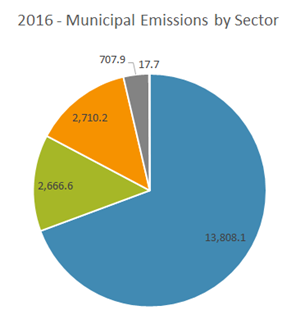Municipal GHG Inventory
Greenhouse Gas Emissions Inventories
Emissions from Cambridge’s municipal operations are fairly small relative to many sources of emissions worldwide, and even to emissions from other cities’ municipal operations.
Nonetheless, it is important that the City address its greenhouse gas (GHG) emissions in order to take responsibility for its own impact, and to demonstrate what is possible with leadership and innovation. The City of Cambridge is taking responsibility for its emissions by annually measuring the emissions from our municipal operations, setting targets, taking actions to achieve those targets. For some examples of the City’s policies and projects that reduce GHG emissions, see the below report.
Completing a municipal greenhouse gas inventory gives us a metric for measuring the impacts of those policies and projects on municipal GHG emissions, and also demonstrates a best practice in GHG management.
About the Municipal Operations GHG Emissions Inventory
City of Cambridge Municipal GHG emissions from 2008 through 2016 were inventoried using The Climate Registry’s Local Government Operations Protocol (LGOP) and General Reporting Protocol (GRP). The annual emissions inventory is verified every 5 years by an accredited 3rd party consultant. Verification ensures that the reported GHG emissions are complete, transparent, estimated and reported according to TCR’s robust and nationally recognized protocols. Verification activities also ensure that the data collected by the City and provided to the 3rd party consultant is well documented and free of any material errors or omissions.
Municipal GHG Emissions Inventory Results
Total GHG emissions in calendar year (CY) 2016 resulting from municipal operations was 19,910 metric tons of CO2e. This represents 30.1% decrease from CY 2008. Building and other facilities account for the majority of municipal emissions at 69% of total emissions.
2016 Emissions from municipal operations is equivalent to...
Emissions from 1,850 average homes in the U.S.
Emissions savings from 5.8 large wind turbines


Scope 1 emissions have declined across all sectors. The City’s Scope 1 emissions are generated from fuels that are combusted directly onsite, and fugitive emissions. This includes emissions from combustion of natural gas, oil, propane, gasoline and diesel, and fugitive emissions from HFC’s in vehicles, heating, ventilation and cooling (HVAC) equipment and fire suppression systems. Scope 1 emissions reductions are a direct result of reducing combustion of fuel onsite.
Scope 2 emissions have declined across all sectors. Scope 2 emissions are attributed to electricity purchased by the City. The emissions from electricity are generated in the process of producing electricity from the combustion of fossil fuels. The amount of emissions generated from the production of electricity depends on the mix of fuels used to produce the electricity. Scope 2 emissions reduction are a result of both reducing electricity use, as well as the use of cleaner fuels used to produce the electricity.